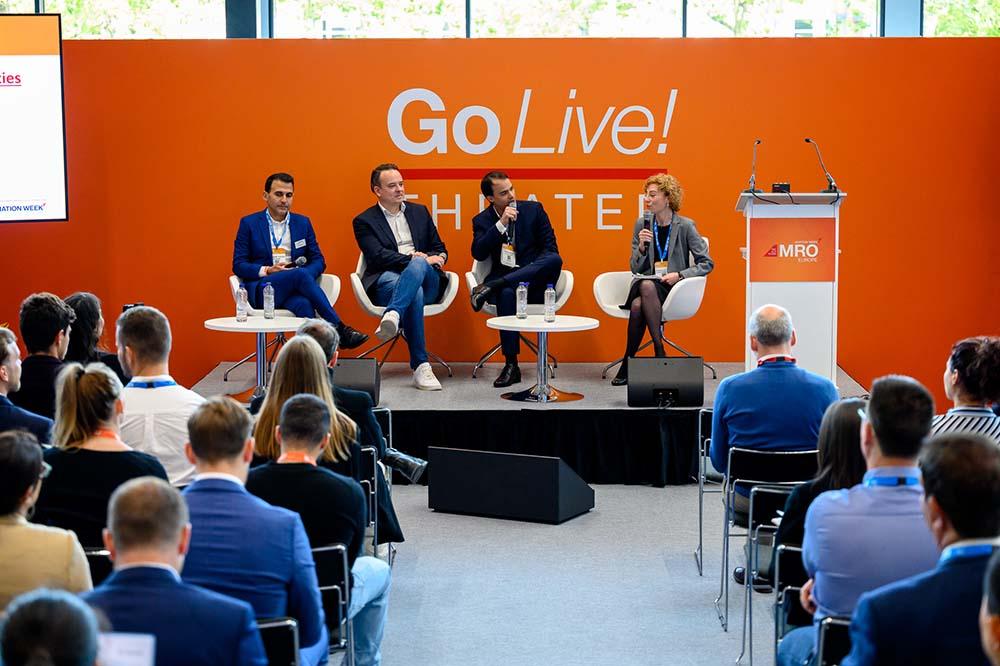
From left: Antoine Ghosn, CEO of services at Dedienne Aerospace; Andreas Perotti, chief marketing officer for Europe at EHang; Todd Siena, founder and CEO of Block Aero; Veronica Dall’Aglio, senior technical manager at Oliver Wyman.
AMSTERDAM— Technologies such as blockchain and digital tooling will bring new opportunities for the aviation aftermarket, but regulation needs to speed up and become a more collaborative process, according to experts.
During a panel at Aviation Week’s recent MRO Europe event, aftermarket experts discussed how the industry is exploring new technologies to boost innovation and improve processes.
At Dedienne Aerospace, the COVID-19 pandemic brought sweeping changes to enhance digital solutions for aircraft tooling. “After the pandemic, we found that everyone wanted tooling the next day or to be available when they needed it because if you don’t have tooling, you cannot do the maintenance,” said Antoine Ghosn, CEO of services at Dedienne Aerospace. In response to the demand, Dedienne partnered with ToolLive, a digital platform dedicated to tooling solutions.
Ghosn says the technology allows customers to find their tooling anytime and anywhere in the world, and to follow the maintenance of their tooling and keep it up to date. “We had a big ramp-up during COVID and today I can report that we have around 150 customers using this platform and the availability rate of the tooling has increased from around 50% to around 98%,” he said.
Digital transformation will likely integrate many different enabling technologies but many of the pain points and inefficiencies creep in due to working in silos, suggested Todd Siena, founder and CEO at Block Aero. “We need to break down those silos and be more collaborative. Blockchain is a fundamental way to build more structured, higher quality and collaborative data sets. There are very important security and safety benefits that blockchain can bring to the industry.”
Siena highlighted the need to have immutability in records management systems. “No matter what country you're in, if you look at the policy, you must have a system which is immutable,” he said. “The industry is in a bit of a crisis now with some of the fraudulent records that are coming into play, so the immutability benefits of blockchain are going to be a game changer on the collaboration, efficiency and safety front.”
Certainly, aviation is one of the world’s most regulated industries. Post-pandemic, Siena sees a transformation in mindset, even with regulators. “[The European Union Aviation Safety Agency] has blockchain initiatives going on right now and it's becoming a growing theme of importance. I think there's been a shift and we are going to see a much faster uptake of blockchain technology,” he said.
Andreas Perotti, chief marketing officer for Europe at advanced air mobility developer EHang, said regulation in the electric vertical-takeoff-and-landing sector is still a challenge. “You have some existing rules but, in most instances, they are not sufficient, not comparable or too exaggerated,” he said.
Perotti feels regulation should always be a collaborative process but acknowledged the huge task regulators face. “They have a lot of pressure from the market, but at the same time they often lack resources in that segment,” he said. “I believe a more global collaboration among the regulators is required.”
When discussing digital solutions, Dedienne’s Ghosn highlighted an important factor: human interaction. “Don't go into a digital project without taking the time to involve your team,” he said. “Take the time to explain your project because you must make everyone believe in it. Otherwise, it’s like a plane that takes off and leaves its passengers on the ground.”





